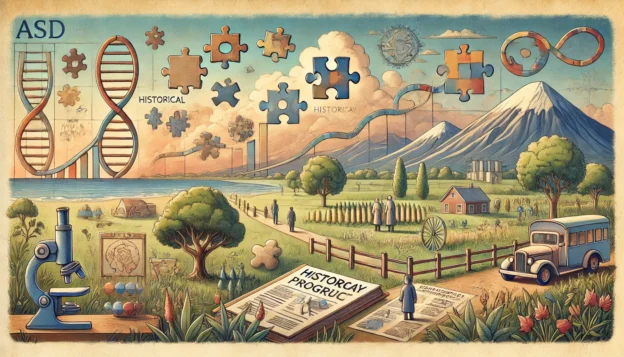Autism Spectrum Disorder (ASD) is a complex developmental condition characterized by social, communication, and behavioural challenges. Initially identified in the early 20th century, ASD was distinctively described by Dr. Leo Kanner in 1943 and Dr. Hans Asperger in 1944. The understanding and diagnostic criteria of autism evolved over time, with the DSM-5 in 2013 consolidating various subtypes under the single diagnosis of ASD, emphasizing a spectrum of symptoms. Advances in genetic and neurological research have deepened understanding, while advocacy and support organizations have promoted awareness and acceptance. The neurodiversity movement and self-advocacy efforts highlight the strengths of individuals with autism, fostering greater societal acceptance and inclusion.
Introduction
Autism Spectrum Disorder (ASD) is a complex developmental condition characterized by challenges with social interaction, communication, and restricted, repetitive behaviors. Understanding the history of ASD involves tracing its identification, changing definitions, and evolving perspectives over more than a century.
Early Observations and Identifications
The concept of autism began to take shape in the early 20th century. In 1911, Swiss psychiatrist Eugen Bleuler first used the term “autism” to describe a subset of symptoms of schizophrenia, indicating a withdrawal from reality. However, it wasn’t until the 1940s that autism was recognized as a distinct condition.
In 1943, Dr. Leo Kanner, an Austrian-American psychiatrist, published a seminal paper describing 11 children who exhibited a unique set of behaviors, including severe social withdrawal, a preference for sameness, and an unusual use of language. He termed this condition “early infantile autism.” Kanner’s work laid the foundation for the understanding of autism as a distinct developmental disorder.
Almost simultaneously, but independently, Austrian paediatrician Dr. Hans Asperger published a paper in 1944 describing a similar, but milder, form of autism in children who demonstrated similar social challenges and restricted interests but had average to above-average intelligence and language development. This condition would later be known as Asperger’s Syndrome.
Evolution of Diagnostic Criteria
The recognition of autism as a distinct condition led to its inclusion in the Diagnostic and Statistical Manual of Mental Disorders (DSM) published by the American Psychiatric Association. In 1980, the DSM-III included “infantile autism” as a distinct diagnosis, separate from childhood schizophrenia. The criteria focused on the presence of social, communicative, and behavioural challenges manifesting before 30 months of age.
The DSM-IV, published in 1994, expanded the concept of autism into a spectrum, introducing the term “Autistic Disorder” and including Asperger’s Syndrome, Pervasive Developmental Disorder-Not Otherwise Specified (PDD-NOS), and Childhood Disintegrative Disorder under the umbrella of Pervasive Developmental Disorders (PDD).
The most significant change came with the DSM-5 in 2013, which consolidated all subtypes under the single diagnosis of Autism Spectrum Disorder (ASD). This change reflected a growing understanding that autism exists on a spectrum, with varying degrees of severity and manifestations. The new criteria emphasized the presence of persistent deficits in social communication and interaction, along with restricted, repetitive patterns of behaviour, interests, or activities.
Advances in Understanding and Advocacy
Throughout the latter half of the 20th century and into the 21st century, significant advances in the understanding of autism have occurred. Research into the genetic, neurological, and environmental factors contributing to autism has expanded, although no single cause has been identified. The role of genetics has become increasingly evident, with numerous genes implicated in the development of ASD.
The rise of advocacy and support organizations has been a crucial part of the history of autism. In 1965, the Autism Society of America was founded, becoming one of the first organizations dedicated to raising awareness and supporting individuals with autism and their families. In 2005, Autism Speaks was established, becoming one of the largest autism advocacy organizations globally. These groups have played a vital role in funding research, providing resources, and advocating for policies that support the autism community.
Shifts in Perspectives and Acceptance
Public perception and acceptance of autism have undergone significant changes. Early views often focused on autism as a tragic condition requiring a cure. However, contemporary perspectives increasingly emphasize neurodiversity, recognizing that individuals with autism have unique strengths and abilities. The neurodiversity movement advocates for acceptance and inclusion, promoting the idea that neurological differences should be respected and valued.
The rise of self-advocacy within the autism community has also been influential. Autistic individuals, such as Temple Grandin, an animal science professor, and writer, and John Elder Robison, an author and neurodiversity advocate, have shared their experiences, contributing to greater understanding and acceptance.
Conclusion
The history of Autism Spectrum Disorder is a story of evolving understanding, shifting definitions, and growing advocacy. From its early identification by pioneers like Leo Kanner and Hans Asperger to the modern perspective of autism as a spectrum and part of the broader neurodiversity paradigm, our understanding of ASD has come a long way. As research continues and societal attitudes progress, the future holds promise for greater support, acceptance, and inclusion of individuals with autism.
